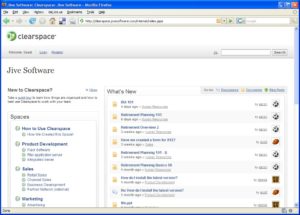Jeffrey Walker and Stewart Mader of Atlassian spoke next on “Collective Intelligence: Monkeys or Memes?” (great title, making reference to the infinite monkey theorem), which was really about adoption patterns of enterprise wikis.
This is really going back to the theory that the IQ level of an appropriately organized collective can be greater than that of the smartest person in that group, and that’s the whole reason for using wikis in the first place, especially in a corporate environment, instead of just picking the smart guy to write the thing.
There’s some significant drivers for Enterprise 2.0 software, and they’re not all about the functionality: some are about the fact that it’s lightweight, easy to install (or software as a service, requiring no installation), easy to customize, and doesn’t require months for the IT department or a third-party system integrator to create a working solution. Many companies, however, still believe that anything that can be up and running in less than 6 months is just a toy; this attitude is driven by IT departments trying to hold onto their job security in a world where the new applications and tools cause an ever-increasing commoditization of their role.
Walker was a very engaging speaker, quite funny and lots of great material. He spoke about some of the advantages of enterprise blogging, whether purely internal or external-facing, and some interesting differences in how companies approach external-facing blogs: Sun just lets you go to town, whereas Cisco requires that you have VP approval and go through corporate communications in a process that must discourage many potential bloggers long before they’re (inevitably) turned down. He recommended checking out IBM’s blogging policy as a good balance for enterprises; having talked with a few IBM employees who also blog, I’ve heard the same thing from them.
Not for the first time this week, I’ve heard SAP’s developer network used as a great example of using blogs and wikis with their external community.
Pixar uses a wiki for project management of all film productions that they do; it started out in their IT and software development areas, but gradually moved into the business areas, which Walker feels is a typical adoption pattern. He also thinks that Enterprise 2.0 adoption is going to look a lot different in the next year than it has in the past year due to the ever-increasing momentum, market presence, and consumer awareness.
He finished up talking about Twitter, not just as a personal social networking tool, but as a platform that’s starting to be investigated by organizations like BART and LAFD to provide public service announcements via SMS. I’ve always seen Twitter as redundant with something like my Facebook updates or a my Skype status, but seeing some non-personal uses of it all of a sudden makes it really interesting.
Mader came up next to talk about some examples of what’s happened with collective intelligence. He’s the author of the book Using Wikis in Education, and used a wiki to collaborate with several others in order to move from material that he had published in his blog into full-on collaborative authoring. He also talked about how he boosted the level of collaboration by creating a Facebook group, which gained more members in a number of weeks than the number of readers his blog reached in several months; this really points out that Facebook is inherently a more social environment (duh) than the more passive activity of reading blogs, and the very act of someone adding themselves to the Facebook group would cause its presence to be extended to that person’s contacts, which is not true if someone is just reading your blog.
He took us through some of the content on wikipatterns.com, a site that Atlassian sponsors, which contains both people and adoption patterns and anti-patterns: another great resource if you’re considering an enterprise wiki and want to assist its adoption. He also talked about some of the challenges of enterprise wiki adoption: overcoming resistance to change, establishing the right scope, gaining trust amongst the contributors (usually manifested in questions such as “someone else can change what I wrote?” and “how can I approve edits?”), and embracing emergent behaviours and making them part of the corporate culture.
Mader addressed an issue straight on that I’ve seen with both blogs and wikis: the attitude that “if I put my expertise in a public forum, I’m no longer an expert”, or “someone will steal my ideas”. I’ve had this argument with several other independent consultants when trying to convince them to blog; it’s a little bit like an architect not wanting anyone to be able to walk through the houses that he designs in case they copy his ideas, when his real value is in both bringing those designs to life and developing new designs, not just selling the old set of plans over and over again. If the only thing that you will ever have to contribute is what you’ve already done in the past, then it’s time for you to retire.
There were some audience questions at the end about people’s need for attribution of material that they author; Mader feels that wiki editing history logs actually provide better attribution than an emailed Word document, and that the new generation of workers are more likely to be used to this form of collaboration. Attribution is an illusion anyway in this world of copy-and-paste; I’ve sent two documents to a client in the past several days, only to find that they copied the text out of my corporate template and put it into their own template before distribution within their company.

